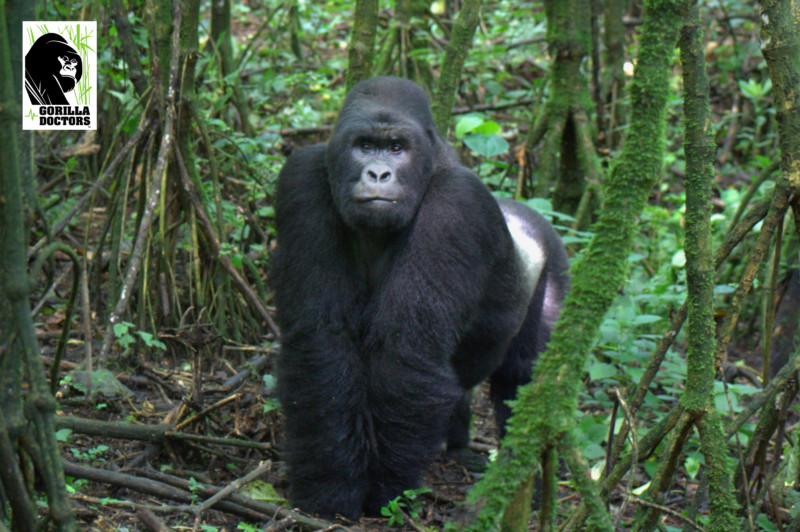Death of Silverback Noel
By Gorilla Doctors Staff on Friday, December 15th, 2017 in Blog.A silverback in the Rugendo group of Virunga National Park died in late November after extensive efforts to save his life. Gorilla Doctors Africa Director Dr. Mike Cranfield provided his account of this intense and emotional case:
Following reports that Noël had seriously injured himself after falling out of a tree, our Head DRC Field Vet Dr. Eddy immediately trekked to Rugendo group in Virunga National Park to assess Noël, a beloved silverback known for his antics and impressive displays. Gorilla Doctors Africa Director Dr. Mike Cranfield joined Dr. Eddy for the veterinary assessment. With the history of his recent fall, swollen lower leg, and extreme lameness his injury appeared to be a severe sprain of the left ankle.
They administered pain killers and anti-inflammatory medication. He walked about 200 yards that afternoon with the rest of the group but was found moribund in his night nest the next morning. The rest of the group had moved on and Dr. Eddy was able to walk up to him and attach a monitoring device to his ear as well as injecting him with a low dose of anesthetic. When anesthetized, a quick examination showed that the situation was far worse than originally thought. His whole leg was badly swollen and seemed to be full of fluid. A sample of the fluid showed that it was pus and gas from a very severe infection.
During the initial examination, the skin on the outside of the leg split and about a gallon of very smelly fluid came flowing out. The wound was flushed, followed by the administration of antibiotics and fluids. Blood work was done that revealed extreme dehydration and the onset of kidney failure. Over the next few days he was under intensive care with a tarp and blanket to protect him during the cold nights. The situation was demanding as it involved constant fluid therapy, wound management, and fly control.
For the next four days he was anesthetized and given IV fluids and antibiotics on a daily basis. His blood work was starting to improve as was his overall condition, but the situation was still precarious.
After four days of his anesthesia/antibiotics/fluids regimen, it was time to try to back off in the hopes that he regains his appetite. To do this and still supplement him with additional fluids, we used water-filled syringes to squirt the water into his mouth, which he readily accepted. ICCN orphan caregiver Babu was brought in to encourage him to eat and to make sure he was getting the water he needed. The wound was not healing despite regular draining and flushing. Mountain gorillas have a tremendous ability to handle wounds and infections but in this case there was something different. After a couple of days of less aggressive treatments, his condition forced us to return to our intensive care routine from earlier.
He had a will to live and appeared to not just tolerate but accept that we were trying to help. Unfortunately he took a turn for the worse following a seizure on the 25th. Noël’s health continued to decline rapidly despite receiving the best possible around-the-clock care, and on the 27th we finally had to say goodbye to this beloved silverback.
A complete postmortem examination revealed that cellulitis had started in his mid-back region and extended all the way down his left leg to his ankle, spreading across muscle groups. The condition in humans is called dissecting fasciitis: it can start from a fairly minor wound and in humans–despite the ability to have round the clock IV lines and nutritional maintenance–around 40% of the cases result in death and often requires amputation of the limb to save the person’s life. The bacteria causing the same condition in Noel is the second most common bacteria seen in humans.
We are waiting to read the histopathology across the internet with the new technology sponsored by Ellen Weisberg.
This was one of the most difficult medical cases we have had and was emotionally draining since he was an exceptional silverback and a favorite in the Virunga National Park.


 Donate
Donate
